The Art of Tim Burton: The Artist Before The Filmmaker
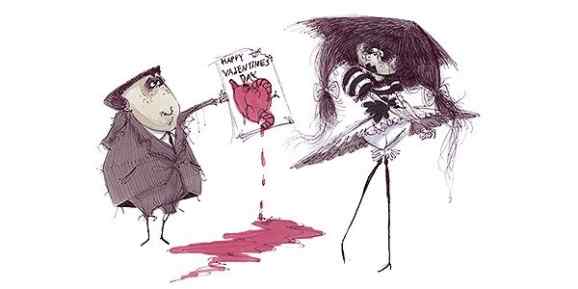
From the very moving Edward Scissorhands to the delirious Dark Shadows, Tim Burton has always been able to carry the audience away into the depths of his imagination. A world full of contradictions, both dark and light, frightening and welcoming, cruel and tender. A world where darkness cohabits with bright colours, where weird-looking people and monsters are brave and generous and where the horrible becomes poetic. Tim Burton has his own style that remains inimitable and his extravagance has become extremely popular. The audience is more familiar with his film work but few are aware of the origins of his films and of his creativity in general. Tim Burton is an artist before anything else. He is a talented drawer who expresses himself through his art. With him a film is often born from a little drawing at the corner of a page. The drawing already sets up the tone of the film, the colours of the set or the personality of a main character. This article pays tribute to the art of Tim Burton, not always well-known but always so rich and so meaningful.
A Compulsive Drawer
Drawing has always been part of Tim Burton’s life. He expresses it as a need and a way to communicate his feelings and ideas. It is part of his everyday life and he always travels with a pencil in his pocket. He draws everywhere, at all time and on everything he gets his hands on. In Leah Gallo’s and Holly C. Kempf’s wonderful book The Art of Tim Burton (based on the exhibition at the MOMA) many of Burton’s personal acquaintances pick on this compulsive need to draw and as his partner Helen Bonham Carter states ‘with him, everything starts with a drawing’. He draws on at least ten notebooks at the same time and if he doesn’t have paper he will use napkins, tissues, tables or walls. Extremely diverse and prolific, he uses different techniques and material – crayons, paints (oil, acrylic, watercolours), markers, pens, glitters and pastels… And with this he succeeds in creating whole worlds. His characters are born on paper, marginal and touching, misunderstood and passionate just like their creator.
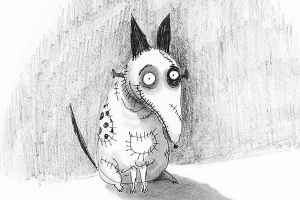
Burton describes this need to draw as a way to focus and to unleash his imagination. As a child, he often felt stifled and different from the other children. He drew monsters to escape the conformity of the American suburb he lived in (Burbank City) and art became his way out. He identified with his characters, timid and left out. Encouraged by his art teacher at school, he developed his own style and started to feel a true aversion for authority and categorisation. Being unusual gave him more artistic freedom and it became a characteristic trait of his art. He started to write and illustrate books for children and became a visual storyteller. As Rick Heinrichs, producer for Frankenweenie, says:
I’ve had the good fortune to see the images Tim dashes off to communicate an important thought to his collaborators. Economically but sublimely drawn, they often put across one simple-but-great-idea. His narrative temperament dictates an expressionistic visual style that selectively reveals the emotional heart of his story: one that entertains without burying meaning beneath multiple layers of expository clutter and gratuitous business’.
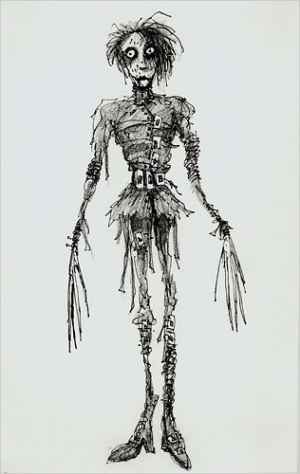
Tim Burton entered the California Institute of Art and worked in animation for Disney but was soon disappointed by the company’s style, which was very different from his own. He was contrived to imitate and create pale imitations of Disney pencil traits with no soul and no emotion. All his independent projects were considered too bizarre to be screened and not adapted for children. It is only after leaving Disney studios that Tim Burton was able to free himself from artistic constrictions and focus on his art which he developed by embracing filmmaking. A film always starts with a drawing. Intuitive, enthusiastic and perfectionist, Tim Burton draws like he breathes. He has never separated his art work from his film work. Johnny Depp recalls his first collaboration with Burton:
“All I had the first time I went to work with Tim on Edward Scissorhands aside from the images arriving in my mind, was a tiny drawing that Tim had made. One look at that drawing was all I needed to understand what Edward was about. It has been exactly the same ever since.”
His Inspirations
People have often compared Burton’s style to the gothic. The use of black, the darkness of some of his drawings, the heavy make-up, the paleness of the skins, monsters and other ghostly creatures recall Gothic literature and paintings but also German Expressionism. The theme of death is omnipresent in Burton’s art often combined with poetry and derision. The macabre becomes comic and poetic. He finds inspiration in the authors he loves like Edgar Allan Poe and Roald Dahl. He admires them for the unconventionality of their stories and the complexity of their worlds far from being just black and white. They are both funny and dark and close to Burton’s own style.
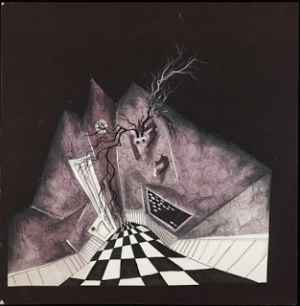
True film buff, Burton’s inspiration can also be linked to the films he used to watch, mainly thrillers, low- budget films, satires, science fiction movies and cartoons. He identifies with Frankenstein and other monsters who are both feared and rejected. At the time he discovered those films, his universe started to expand and his creativity to grow. Watching Technicolor films helped him develop his use of colour in his drawings but also in his short films and he influence can be observed in Edward Scissorhands, with the profusion of pastel colours. He also loved punk music which expressed at the time his desire for rebellion against conventions.
His art is truly representative of his vision of the world and he also finds inspiration in the people who surround him. His drawings are often filled with social commentaries. He reveals the absurdity of our consumerist society and its hierarchical organisation. In one drawing he portrays the company Disney as a powerful dehumanizing machine which crushes any sense of singularity. He caricatures people and their behaviour from girls too obsessed by their physical appearance to a perverse man undressing a woman with his eyes, or a man covered in blood going in a gun shop and asking for more bullets. The suburbs he lived in also inspired him a lot and are at the heart of his film Edward Scissorhands.
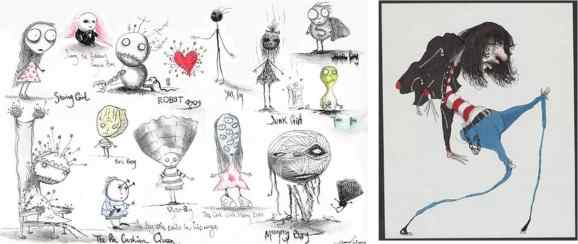
His Aesthetic and Message
Tim Burton refuses to become a label or a brand and doesn’t categorize his art although others did it for him. His style is very recognizable, full of whirlwinds, stripes, seams, asymmetrical figures, winding staircases, monsters with sad eyes and weird hair. In terms of colours, he often uses black, white, purple, red and sometimes bright colours too. Through his drawings he captures feelings more quickly and efficiently than through words. He bases his style on simplicity, clarity, economy and rapidity. Here is how Ian Mackinnon, puppet creator and designer for Mars Attacks!, has described Burton’s style:
‘The real strength in Tim’s artwork is his appreciation of form with strong shapes and exaggerated proportions. Within a few seemingly simple pen lines, he creates bold silhouettes […] You would be mistaken for thinking that some of Tim’s rough sketches are rudimentary, loose or naïve, for they hold vital information, demonstrate a great delicacy, sensitivity, consistent keen eye, and a stunning vision’.
Tim Burton’s imaginary world has now become a familiar one, a world everyone is drawn to. A world which is welcoming and heart-warming, filled with strange-looking people and sad clowns more frightened than frightening. His message is clear: people are not defined by their appearances. To be different does not mean to be excluded and differences should be cultivated along with singularity and creativity. His universe is more appealing than scary even though it is full of outcast characters. Their tragedy inspires more pity than fear and monsters become charming. He shows life as both kind and tragic, beautiful and cruel, funny and disturbing. The horrible becomes tender and poignant and it is the beautiful that becomes scary.
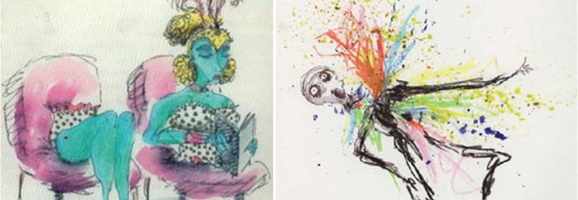
Work Cited
Tim Burton – Leah Gallo – Holly C.Kempf – Derek Frey, The Art of Tim Burton- Steeles Publishing – 2009
What do you think? Leave a comment.











Interesting article! I didn’t realize Tim Burton drew so much. His artistic process is intriguing and translates well into his films.
Yes it is really amazing how much he draws. He kept thousands of drawings in his attic and didn’t want to show anyone, but thanks to the beautiful exhibition around his artwork at the MOMA (it then travelled around the world) and Leah Gallo’s/Holly Kempf’s book, his art is now shown to the public. They spent months going through all the drawings and there are still a lot left in the dark!
Can’t say Tim Burton is an incredible artist, but that’s what makes every piece true.
His artwork is a insight into the mind of such a unique and fantastic director.
I’m a massive fan of Tim Burton. I love the gothic details he adds to his work. This man is an utter genius.
I have always liked Burton’s drawing style – all scratchy, loose and unapologetic – and it is fantastic to see some of his most memorable characters in their initial concept stage.
It was really awesome to see all these drawings! I feel the more I know about Burton the more fantastic he is. I recently saw a dance based on Edward Scissorhands (on the Indian version of Dancing with the Stars). No one had to introduce it as scissorhands; the characters of Burton’s vision are that unique and universally recognized.
Great article 🙂
This was a cool article. Well done. I don’t know anything about Tim Burton, so this was very enlightening.
It’s not easy to write an article about Tim Burton without talking about what people usually fall to: Nightmare Before Christmas and Alice in Wonderland. Though I do think Sweeny Todd is underappreciated. Nie article and nicely written.
Thank you all!
It’s clear from his film work that Burton has a clear and individualistic vision, but I didn’t realize he draws as his primary “rough draft”. Thank you for increasing my understanding of a great artist!
You are more than welcome, and thank you for reading!
his art is amazing. this is a fantastic article
Great glimpse into the dark and beautiful mind of Tim Burton.
His art is amazing, and the childlike quality of work can really get to you.
I love his dark quirkiness and his sense of humor.
Wonderful capture of Tim Burton’s work.
The Nightmare Before Christmas is by far one of my favorite works of his, if only because I grew up watching it.
Tim burton is the greatest artist and film maker of the 21rst century. He’s the reason i chose to be an artist. To meet him would be epic
Brilliant! He’s the modern day Edgar Allen Poe.
Burton’s art is much like an homage to Edward Gorey’s, another master of the macabre.
You might think Burton’s art is cheap and crappy but it’s actually a professional level of drawing. It is cheap cartooning art but it takes a pro to master it like Burton!
The thing I love about Tim is that he can take what the world calls “doodles” and turn them into living, breathing, art that is believable and real. And twist them.
I love Tim’s art, Tim’s stories, Tim’s movies he’s amazing. A great artist for cartooning and a great writer also.
He needs to get back to this kind of art and stop making crappy remakes. That guy was THE MAN, but he’s lost it.
Great article. The drawings alone are breathtaking but the way his films bring them to life is always a marvel to behold.
You’ve provide excellent insightabout Tim Burton. This definitely explains where his distinct style comes from and I love that he still sticks to his roots!
Time Burton’s art in the esthetic sense it truly amazing,however what does it for me with Burton’s work is the style the rebelling against modern art. In today’s art everywhere you look is the use of computers or other aids to create a piece of art, but Burton seems to keep his art in the purest sense by simply sketching them from his imagination, and that is what is amazing, Burton’s work is a display of his imagination. Another aspect of Burton that demands respect is that in many of his movies he creates from using clay models and creating each scene by moving the clay by hands, now that is truly amazing.
Fantastic article! I really enjoyed the details you provided about his professional life in the beginning. It’s fascinating and encouraging to hear about an artist who was able to be successful without compromising their individual style. Tim Burton got swag, yo.
I never knew that Tim burton was a drawer, I was just aware of his movies. I can see now how his movies and actors always go so flawlessly together. Giving hem drawing and allowing them to really see the characters attitude, emotion, etc. I love his work and this just inspires me to look more into his artwork. He’s not afraid to be unique and independent from the norm.
First of all, this article is well written and organized. Having gotten The Art of Tim Burton for Christmas a few years ago, I found this article as a helpful addendum to the book. When I was younger, Tim Burton’s movies were a huge influence to me growing as an artist. I would cite him as one of my first real inspirations that I felt I could relate too. Later, I discovered his drawings and was amazed. Seeing how his style developed and where his inspirations lie pushed me to search for my personal style and find true inspirations.
When ever I try to draw in a gothic style, I always implement Tim Burton’s style because he has such a distinctive style. Even if I don’t like a film he made, I still love his worlds he creates.
This is a very thorough and yet succinct summary and evaluation of Burton’s art style and inspiration. After seeing how understated Big Eyes was stylistically, it’s comforting to revisit the aesthetic of his older work.
Great that you mentioned how he was influenced by the German expressionist movement! Once I looked at German expressionist movies, I saw Burton in a new light.
I made a pilgrimage to New York City to see his exhibition at the MOMA. It was one of the most fascinating and beautiful exhibits I have ever seen. It certainly did not disappoint and it was amazing to see his style transcend mediums.
This is an enlightening piece on Tim Burton’s drawings. It is an interesting phenomenon that so many of his movies are admired yet his drawings are rarely exhibited. I did have the fortune of seeing the exhibit you mentioned at MOMA. Of particular interest is your discussion of Burton’s compulsive drawing. The desire and need to produce these fantastical images is an elusive concept that leads one to question where an artist’s inspiration originates and validates the importance placed upon the artistic process as an ethereal attribute. Thank you for this wonderful article on Burton’s drawings.
I never saw the connections to German Expressionism but I’ve always wanted to adopt a Burton-like style when directing Expressionist plays like Spring’s Awakening or The Adding Machine.
Timothy Burton, is wonderful. He always inspires me to draw more and more . To never give up no matter what people say about my drawings.
really enjoyed the article! good job!
It is amazing what comes out of Tim Burtons mind. Absolutley fascinating. I saw his show in Toronto and would love to see it again.
What is Tim’s most famous piece of artwork, I’d like to know for a report I’m doing on him
Beautifully written article.
this is AWSOME I was wanting to be an artist or something and now Tim Burton has inspired me
The fact that Tim Burton began as a drawer explains his Nightmare Before Christmas art style.
Thanks for this article! Tim Burton is one of my main influences for my dark and light French project.